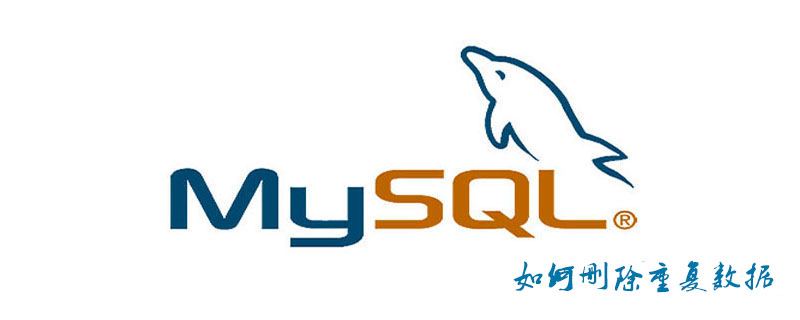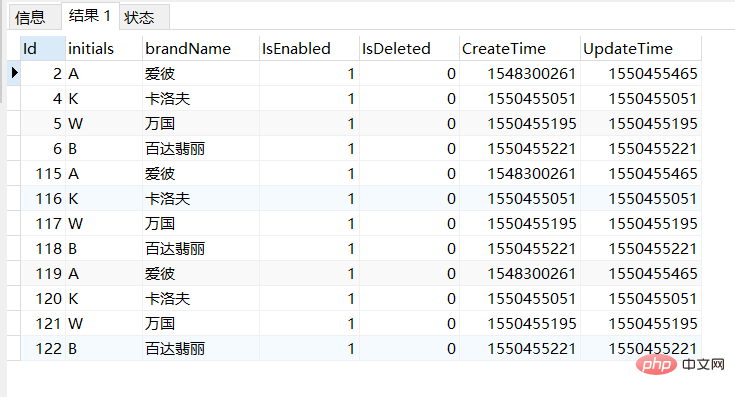How to delete duplicate data in MySQL
Duplicate checking is a need we often encounter in our work. The following article mainly introduces you to the relevant information about MySQL querying duplicate data (deleting duplicate data and keeping the one with the smallest ID as the unique data). In the article The sample code is introduced in great detail and has certain reference value for everyone's study or work.
Recommended courses: MySQL Tutorial.

Recently I am working on a batch data import function into the MySQL database. From the batch import, we can know that such data will not be repeatedly judged before being inserted into the database. Therefore, only after all the data is imported, a statement can be executed to delete it to ensure the uniqueness of the data.
Not much to say below, let’s take a look at the detailed introduction
The table structure is as shown below:
Table Name: brand

Operation
Use SQL statements to query duplicate data:
SELECT * from brand WHERE brandName IN( select brandName from brand GROUP BY brandName HAVING COUNT(brandName)>1 #条件是数量大于1的重复数据 )
Use SQL to delete redundant duplicate data and retain the unique piece of data with the smallest ID:
Note:
Wrong SQL :DELETE FROM brand WHERE brandName IN (select brandName from brand GROUP BY brandName HAVING COUNT(brandName)>1)
AND Id NOT IN (select MIN(Id) from brand GROUP BY brandName HAVING COUNT(brandName)>1 )
Tip: You can't specify target table 'brand' for update in FROM clause You can't specify target table 'brand' for update in FROM clause
The reason is: the directly investigated data cannot be used as a condition for deleting data. We should first create a temporary table for the detected data, and then use the temporary table as a condition for deletion function
正确SQL写法: DELETE FROM brand WHERE brandName IN (SELECT brandName FROM (SELECT brandName FROM brand GROUP BY brandName HAVING COUNT(brandName)>1) e) AND Id NOT IN (SELECT Id FROM (SELECT MIN(Id) AS Id FROM brand GROUP BY brandName HAVING COUNT(brandName)>1) t) #查询显示重复的数据都是显示最前面的几条,因此不需要查询是否最小值
The results are as follows: 

Summary:
Many things need to be done by yourself It is explored step by step. Of course, the suggestions on the Internet are also very valuable reference and resources. No matter what development we do, we need to understand its working principle in order to better master it.
The above is the detailed content of How to delete duplicate data in MySQL. For more information, please follow other related articles on the PHP Chinese website!

Hot AI Tools

Undresser.AI Undress
AI-powered app for creating realistic nude photos

AI Clothes Remover
Online AI tool for removing clothes from photos.

Undress AI Tool
Undress images for free

Clothoff.io
AI clothes remover

Video Face Swap
Swap faces in any video effortlessly with our completely free AI face swap tool!

Hot Article

Hot Tools

Notepad++7.3.1
Easy-to-use and free code editor

SublimeText3 Chinese version
Chinese version, very easy to use

Zend Studio 13.0.1
Powerful PHP integrated development environment

Dreamweaver CS6
Visual web development tools

SublimeText3 Mac version
God-level code editing software (SublimeText3)

Hot Topics
 1657
1657
 14
14
 1415
1415
 52
52
 1309
1309
 25
25
 1257
1257
 29
29
 1230
1230
 24
24
 MySQL's Role: Databases in Web Applications
Apr 17, 2025 am 12:23 AM
MySQL's Role: Databases in Web Applications
Apr 17, 2025 am 12:23 AM
The main role of MySQL in web applications is to store and manage data. 1.MySQL efficiently processes user information, product catalogs, transaction records and other data. 2. Through SQL query, developers can extract information from the database to generate dynamic content. 3.MySQL works based on the client-server model to ensure acceptable query speed.
 How to start mysql by docker
Apr 15, 2025 pm 12:09 PM
How to start mysql by docker
Apr 15, 2025 pm 12:09 PM
The process of starting MySQL in Docker consists of the following steps: Pull the MySQL image to create and start the container, set the root user password, and map the port verification connection Create the database and the user grants all permissions to the database
 Laravel Introduction Example
Apr 18, 2025 pm 12:45 PM
Laravel Introduction Example
Apr 18, 2025 pm 12:45 PM
Laravel is a PHP framework for easy building of web applications. It provides a range of powerful features including: Installation: Install the Laravel CLI globally with Composer and create applications in the project directory. Routing: Define the relationship between the URL and the handler in routes/web.php. View: Create a view in resources/views to render the application's interface. Database Integration: Provides out-of-the-box integration with databases such as MySQL and uses migration to create and modify tables. Model and Controller: The model represents the database entity and the controller processes HTTP requests.
 Solve database connection problem: a practical case of using minii/db library
Apr 18, 2025 am 07:09 AM
Solve database connection problem: a practical case of using minii/db library
Apr 18, 2025 am 07:09 AM
I encountered a tricky problem when developing a small application: the need to quickly integrate a lightweight database operation library. After trying multiple libraries, I found that they either have too much functionality or are not very compatible. Eventually, I found minii/db, a simplified version based on Yii2 that solved my problem perfectly.
 Laravel framework installation method
Apr 18, 2025 pm 12:54 PM
Laravel framework installation method
Apr 18, 2025 pm 12:54 PM
Article summary: This article provides detailed step-by-step instructions to guide readers on how to easily install the Laravel framework. Laravel is a powerful PHP framework that speeds up the development process of web applications. This tutorial covers the installation process from system requirements to configuring databases and setting up routing. By following these steps, readers can quickly and efficiently lay a solid foundation for their Laravel project.
 MySQL and phpMyAdmin: Core Features and Functions
Apr 22, 2025 am 12:12 AM
MySQL and phpMyAdmin: Core Features and Functions
Apr 22, 2025 am 12:12 AM
MySQL and phpMyAdmin are powerful database management tools. 1) MySQL is used to create databases and tables, and to execute DML and SQL queries. 2) phpMyAdmin provides an intuitive interface for database management, table structure management, data operations and user permission management.
 MySQL vs. Other Programming Languages: A Comparison
Apr 19, 2025 am 12:22 AM
MySQL vs. Other Programming Languages: A Comparison
Apr 19, 2025 am 12:22 AM
Compared with other programming languages, MySQL is mainly used to store and manage data, while other languages such as Python, Java, and C are used for logical processing and application development. MySQL is known for its high performance, scalability and cross-platform support, suitable for data management needs, while other languages have advantages in their respective fields such as data analytics, enterprise applications, and system programming.
 MySQL vs. Other Databases: Comparing the Options
Apr 15, 2025 am 12:08 AM
MySQL vs. Other Databases: Comparing the Options
Apr 15, 2025 am 12:08 AM
MySQL is suitable for web applications and content management systems and is popular for its open source, high performance and ease of use. 1) Compared with PostgreSQL, MySQL performs better in simple queries and high concurrent read operations. 2) Compared with Oracle, MySQL is more popular among small and medium-sized enterprises because of its open source and low cost. 3) Compared with Microsoft SQL Server, MySQL is more suitable for cross-platform applications. 4) Unlike MongoDB, MySQL is more suitable for structured data and transaction processing.




